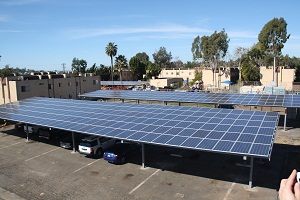Week in review: Solar heads into the fall
 As the solar industry heads into the fall—and Solar Power International, which will likely dominate the headlines this week—it’s showing some significant signs of life, but as always, there remain some challenges to the industry. As usual, they include cost and policy issues, meanwhile installations continue to grow and companies are lining up to make solar as effective as possible.
As the solar industry heads into the fall—and Solar Power International, which will likely dominate the headlines this week—it’s showing some significant signs of life, but as always, there remain some challenges to the industry. As usual, they include cost and policy issues, meanwhile installations continue to grow and companies are lining up to make solar as effective as possible.
First off, the bad news, a new report found that the current pressure to keep the costs of photovoltaics low, could be the most detrimental to the industry. That’s according to Navigant’s 7th annual Analysis of Worldwide Markets for Solar Products and Five-Year Application Forecast. The report found that among other things, strong incentives, like feed-in tariffs, may hurt the industry because they have encouraged more companies to enter into the market in the hopes for strong earnings, while undercutting competitors. The competition to produce ever-cheaper modules also could create lower-quality PV modules and force more companies out of business.
On the policy side the U.S.’s biggest solar market, California, failed to pass S.B. 843, solar legislation for community solar gardens. Currently the state doesn’t allow people to buy electricity directly from energy producers, like community solar gardens, which the legislation would have allowed. However the legislation was in flux up until it was voted on, and though watched by the California Solar Energy Industries Association, the advocacy organization did not take a stance on the bill.
In the quest to make solar projects produce to their upmost capacity, new companies continue to offer new solutions. For instance, Qbotix, is launching its dual-axis solar tracking robots.The approach is unique in that instead of using hundreds or even thousands of individual mechanical, powered trackers, Qbotix’ system uses a robot—or series of robots—on tracks to travel around on a track and adjust each tracker throughout the day. The approach reduces the amount of mechanical equipment needed in the field and the possibility of equipment failure.
Another key to making solar more effective for grid integration is forecasting. That’s the idea behind Locus Energy’s Virtual Irradiance engine, which is debuting at Solar Power International this week in Orlando, Fla. The engine allows utilities, power producers and others to better predict how well a solar system will perform on a given day, using real-time weather data and the company’s proprietary algorithms. That way they can better anticipate how much power will be needed from other sources and when it is needed. The system, being launched in beta, will be offered as an add-on for the company’s SolarOS monitoring platform.
On the residential side of things, third-party ownership has taken off over the past few years. To explain how the offerings are effective and why they should be offered in more states, Sungevity founder Danny Kennedy has published “Rooftop Revolution”, a book that explains the economic case for third-party ownership. Among other things the book highlights solar power’s jobs creation over the past few years.
Last year, as more electric vehicles were introduced the world over, they were followed by the introduction of solar-powered EV charging stations. The trend is continuing. Recently the San Diego Zoo announced that it is putting in 90 kilowatts of photovoltaic powered EV chargers that will cover about 50 parking spaces. The system will power 5 charging stations and a 100 kilowatt battery storage system. The project is being done under Smart City San Diego, a partnership of San Diego, San Diego Gas and Electricity, GE, UC San Diego and CleanTECH San Diego. The project is being done in anticipation of up to 200,000 plug-in EVs in the region by 2020.



